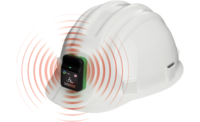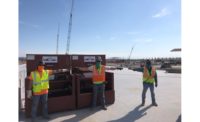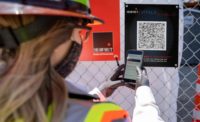Working on a construction site during a viral pandemic can be a harrowing experience, given the close quarters that workers often find themselves in. General rules about social distancing easy to maintain on sidewalks can be more stressful when clambering around a crowded active jobsite.
Across the industry, existing technologies are being quickly adapted to help monitor workers and try to avoid the kind of congestion that could lead to transmission of the COVID-19 virus.
Computer vision paired with artificial intelligence is already in use on construction sites, analyzing photos and video of a site to spot safety hazards and identify possible construction errors. But an idea pitched from a construction contractor has spurred A.I. vendor Smartvid.io to add social distancing monitoring to its feature set.
[For ENR’s latest coverage of the impacts of the COVID-19 pandemic, click here]
“We wouldn’t have done this if not for a customer asking for it,” says Josh Kanner, CEO and founder of Smartvid.io. The company’s A.I., Vinnie, is already able to identify and tag human beings individually from video or still images.
But while chatting with a user a few weeks ago, the idea of how it could help meet new OSHA social distancing recommendations came up. “I just randomly brought up the idea to them,” recalls Jennifer Suerth, vice president of technical services at Pepper Construction. “The big thing with construction continuing to go on is we’ve got some projects where the client is paying for extra labor on site to monitor people [for social distancing] and separate them.”
Suerth suggested that since they were already capturing so many images on site, and Smartvid.io’s AI can already detect where workers are and whether they are wearing PPE like safety gloves, it could monitor grouping as well.
Kanner leapt at the idea and set his team to the task. “We dropped everything to work on it and were able to turn it around in less than three weeks,” he says. The company's A.I. Vinnie is already able to perform some proximity detection of workers for normal safety monitoring, so it was simply a matter of creating a new tag in the system for the AI to note groups of 10 or more people and other forms of crowding.
“Now the user can get a daily, automatic report from every one of their projects in the country on whether social distancing is happening or not,” explains Kanner. “The idea isn’t to slam anybody or get them in trouble but to give an indicator for safety.” Smartvid.io users can also watch the program at work in real-time on live video and photos from their jobsites.
Smartvid.io integrates into major project management software from Procore, Autodesk and Oracle, and it is able to generate one-click safety observations from both the Procore and Autodesk systems. It is also available as a standalone app.
“They showed me what they were doing the other day and talked through some scenarios, and I was really impressed,” says Suerth. “It just shows that safety is the number one priority, and right now social distancing is the one thing people are talking about.”
“However we ran jobsites two months ago will look totally different from how we run them in two to six months down the road,” says Ted Jennings, senior VDC manager at Barton Malow. “This isn’t just a storm we wait out—there will be different safety and health procedures put in place.”
Jennings says Barton Malow has been using Smartvid.io for about a year, and he thinks the new social distancing feature is a good step. The company already uses StructionSite for site documentation, so it has a steady supply of photos to run through the A.I. “Seriously though, props to Smartvid for being able to quickly adapt their A.I. to social distancing. I’m really interested to see what other software [providers] are going to do to help with COVID-19.”
The new Smartvid.io tag, People in Group, will be available on the platform starting April 6, says Kanner. The company also announced it is making its software free for the next two months.







Post a comment to this article
Report Abusive Comment